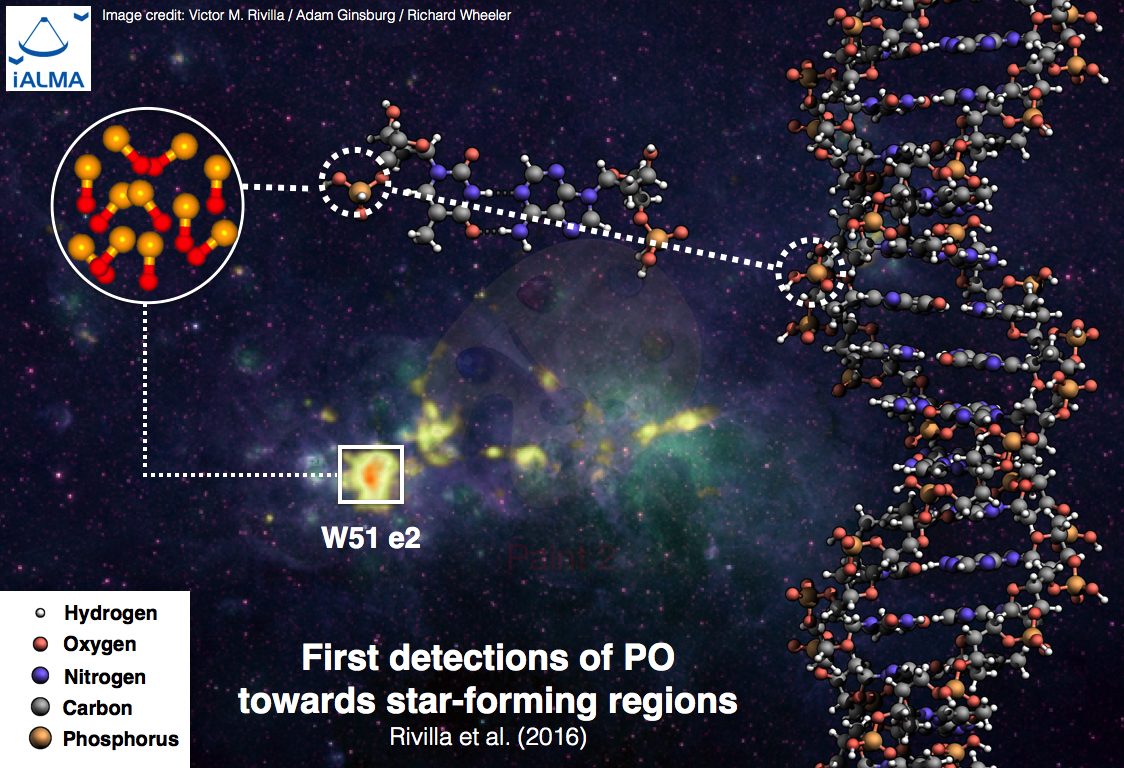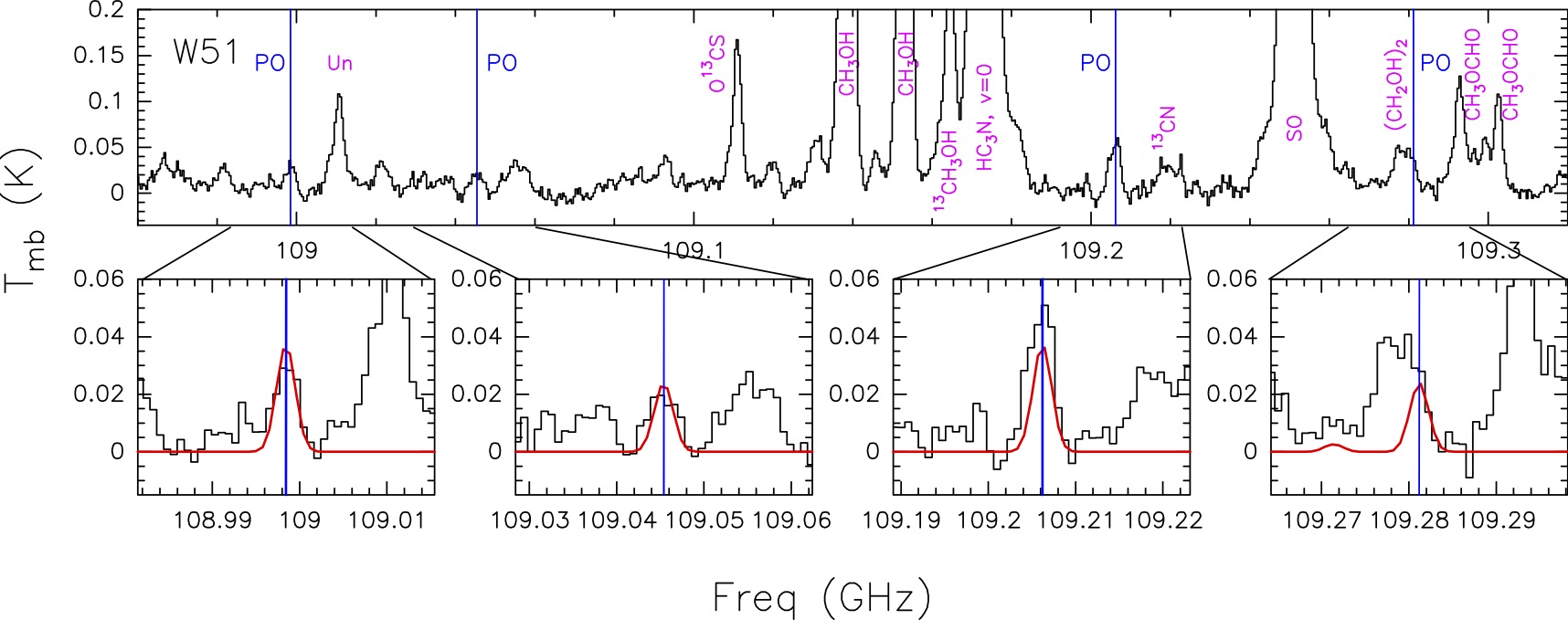News
First detections of the key prebiotic molecule P-O in star-forming regions
An international group of scientists from the Arcetri Astrophysical Observatory (INAF-OAA, Florence, Italy), the Center of Astrobiology (CAB-CSIC, Madrid, Spain) and the Max-Plank Institute for Extraterrestrial Physics (MPE, Garching, Germany) has detected for the first time the prebiotic molecule P-O in star-forming regions. This molecule plays a key role in the double helix structure of DNA, and is therefore directly linked to the origin of life in the Universe.
 |
In the past few years, new generation of telescopes have allowed the astronomers to detect in the interstellar medium molecules that play an important role in prebiotic chemistry. These molecules are considered the building blocks of the first living organisms, and therefore their study can shed light about the origin of life in the Universe.
One of the key elements for the development of life is phosphorus (P). Chemical compounds containing phosphorus, such as phospholipids and phosphates, are essential for the structure and energy transfer in cells. Especially important is the chemical bond between phosphorus and oxygen, P-O, which is crucial for the formation of the backbone of the deoxyribonucleic acid, DNA, the macromolecule that contains the generic information of living organisms. “Despite its astrobiological relevance, the P-O molecule had not been previously detected in the regions where stars are formed”, says Víctor M. Rivilla, an astronomer of the Arcetri Observatory in Florence (INAF-OAA). “We were very interested in finding this molecule in the cradle of stars, because this would mean that one of the basic pieces of the DNA is already available in the gas that will form the planets where life may originate. So we started a project to search for P-O in star-forming regions”.
Indeed, the group of astronomers led by Dr. Rivilla has recently detected the prebiotic molecule P-O for the first time in two star-forming regions in our galaxy: W51 e1/e2 and W3(OH). This important discovery has been recently accepted for publication in The Astrophysical Journal. The observations were carried out with the IRAM 30m radio telescope at Pico Veleta. The results of this work indicate that the abundance of phosphorus in star-forming regions is more than ten times higher than previously thought. “This study is telling us that phosphorus is an important and relatively abundant ingredient to ‘cook’ stars, planets and maybe also life”, says Francesco Fontani (INAF-OAA), coauthor of the work.
 |
| Spectrum observed towards the star-forming region W51 e1/e2 using the IRAM 30m-size radio telescope located in Pico Veleta (Granada, Spain). Several molecular species have been identified by the astronomers (methanol, methyl formate...) including the key prebiotic molecule PO, detected for the first time in star-forming regions. |
The star formation group at the Arcetri Astrophysical Observatory, partially funded by the Italian Premiale Project iALMA, is a world-leading group in the detection and study of interstellar molecules with astrobiological interest. “Some years ago, we already discovered the presence of the simplest sugar in a star-forming region, glycolaldehyde. Both sugars and compounds with phosphorus are the building blocks of the double helix of DNA”, adds Maite Beltrán (INAF-OAA), coauthor of the work. “Therefore, step by step, our findings are helping us to understand how life could be originated in space”.
These first detections of the P-O chemical bond towards star-forming regions have profound implications for the prebiotic chemistry. “So far only molecules containing hydrogen, carbon, oxygen and nitrogen had been studied in detail in star-forming regions. After our discoveries we can now start to study the chemistry of phosphorus in the interstellar medium, which will give us important clues about how the chemical complexity can grow to form more complex molecules with astrobiological relevance”, says Jesús Martín-Pintado (CAB-CSIC), coauthor of the work.
“This discovery is a groundbreaking result. The search for prebiotic molecules in star-forming regions is still in its infancy but another building block of life has been found and this brings more excitement to the field of astrochemistry. The future is bright, thanks to great instruments such as the IRAM 30m telescope, the NOEMA Interferometer and ALMA, available nowadays”, says Paola Caselli, coauthor of the work and Director of the Max-Planck Institute for Extraterrestrial Physics.
More info:
Reference: V. M. Rivilla, F. Fontani, M. T. Beltrán, A. Vasyunin, P. Caselli, J. Martín-Pintado, and R. Cesaroni, “First detections of the key prebiotic molecule PO in star-forming regions”, accepted for publication in “The Astrophysical Journal”. The article is already available online at : http://arxiv.org/abs/1605.06109
Contact: Víctor M. Rivilla, Osservatorio Astrofisico di Arcetri, Firenze, email: rivilla@arcetri.astro.it

